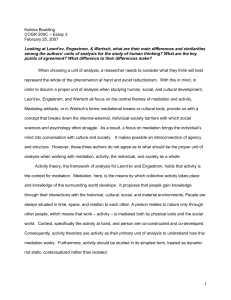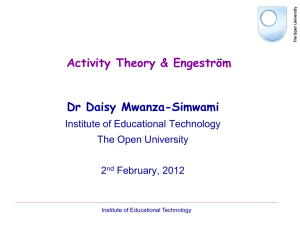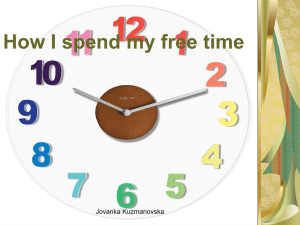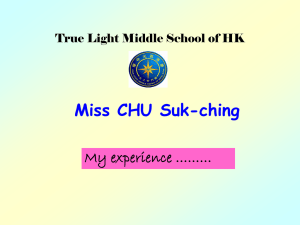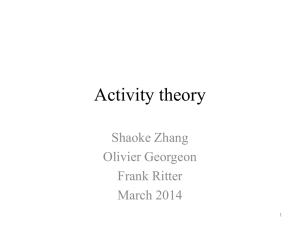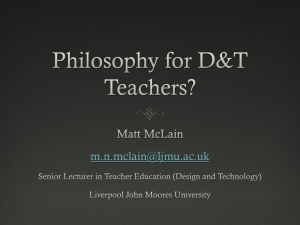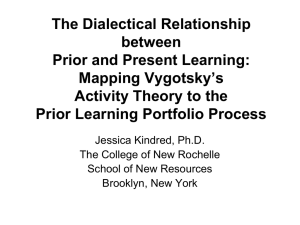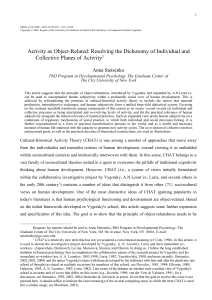Activity theory - Carleton University
advertisement
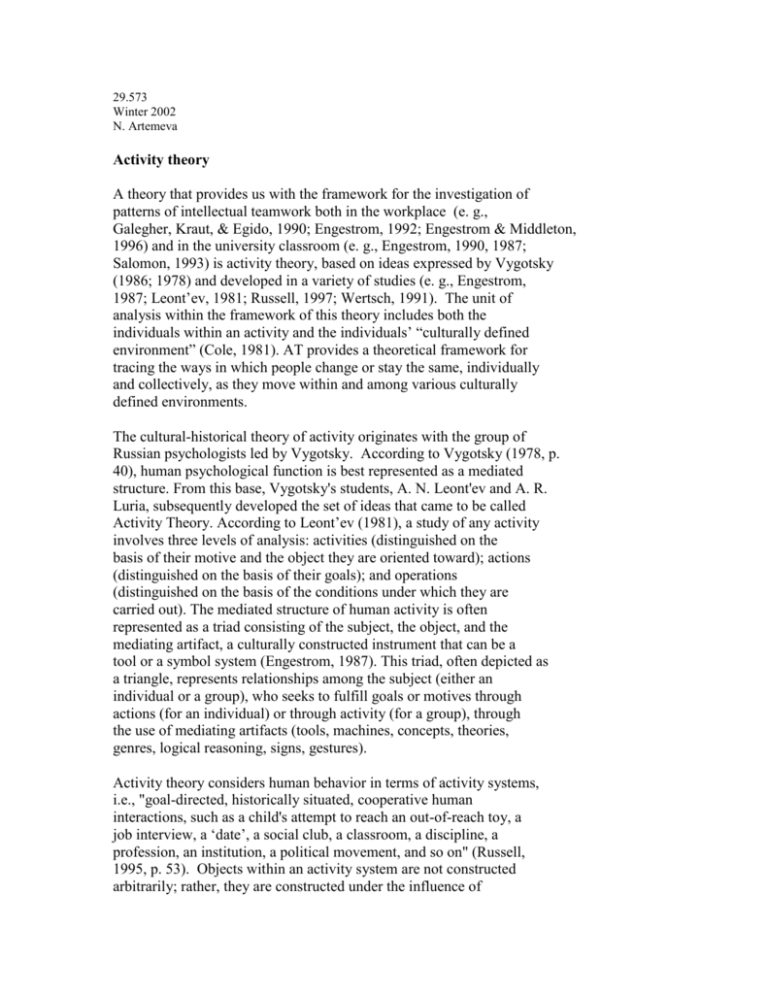
29.573 Winter 2002 N. Artemeva Activity theory A theory that provides us with the framework for the investigation of patterns of intellectual teamwork both in the workplace (e. g., Galegher, Kraut, & Egido, 1990; Engestrom, 1992; Engestrom & Middleton, 1996) and in the university classroom (e. g., Engestrom, 1990, 1987; Salomon, 1993) is activity theory, based on ideas expressed by Vygotsky (1986; 1978) and developed in a variety of studies (e. g., Engestrom, 1987; Leont’ev, 1981; Russell, 1997; Wertsch, 1991). The unit of analysis within the framework of this theory includes both the individuals within an activity and the individuals’ “culturally defined environment” (Cole, 1981). AT provides a theoretical framework for tracing the ways in which people change or stay the same, individually and collectively, as they move within and among various culturally defined environments. The cultural-historical theory of activity originates with the group of Russian psychologists led by Vygotsky. According to Vygotsky (1978, p. 40), human psychological function is best represented as a mediated structure. From this base, Vygotsky's students, A. N. Leont'ev and A. R. Luria, subsequently developed the set of ideas that came to be called Activity Theory. According to Leont’ev (1981), a study of any activity involves three levels of analysis: activities (distinguished on the basis of their motive and the object they are oriented toward); actions (distinguished on the basis of their goals); and operations (distinguished on the basis of the conditions under which they are carried out). The mediated structure of human activity is often represented as a triad consisting of the subject, the object, and the mediating artifact, a culturally constructed instrument that can be a tool or a symbol system (Engestrom, 1987). This triad, often depicted as a triangle, represents relationships among the subject (either an individual or a group), who seeks to fulfill goals or motives through actions (for an individual) or through activity (for a group), through the use of mediating artifacts (tools, machines, concepts, theories, genres, logical reasoning, signs, gestures). Activity theory considers human behavior in terms of activity systems, i.e., "goal-directed, historically situated, cooperative human interactions, such as a child's attempt to reach an out-of-reach toy, a job interview, a ‘date’, a social club, a classroom, a discipline, a profession, an institution, a political movement, and so on" (Russell, 1995, p. 53). Objects within an activity system are not constructed arbitrarily; rather, they are constructed under the influence of "historically accumulated collective experience, fixated and embodied in mediating artifacts" (Engestrom, 1990, p. 108). Further, activity does not exist without a motive; there is always some need that impels the activity. However, the subjects involved may not necessarily be able to formulate this motive in explicit language. Activities that seem "unmotivated" to an observer are not necessarily activities without a motive; rather, the motives of such activities are subjectively or objectively concealed (Leont'ev, 1981) Engestrom (1987) expanded Leont'ev's basic mediational triangle to a larger activity system, including Rules, Community and Division of Labor as nodes of an expanded triangle. He suggested that the triadic structure of the basic mediational triangle (person-artifact-task, or subject-tool-object) should be extended to account for the socially distributed and interactive nature of human activity. Engestrom (1989) describes activity as being realized in the form of individual goal-oriented actions. However, it cannot be reduced to the sum of such actions. Actions are discrete, whereas an activity is a system of collective practice based on its inner division of labour. Different and often conflicting individual views on the motive and the object are united within an activity system. Activity systems are complex formations in which tensions, contradictions, disturbances, and "local innovations are the rule and the engine of change" (Cole & Engestrom, 1993, p. 8). If we examine the principles of rhetorical genre studies from the perspective of activity theory, we will see that genres for long-time participants in a certain activity system (i. e., members of a certain community of practice) become operationalized with time. However, for a newcomer “the writing of such genres is an effort of deliberate, goal-directed action, an effort which with growing familiarity with the reading and writing practice of that activity system, will eventually become operationalized [sic]” (Dias, 2000, p. 18). Adopting the activity theory perspective in the research into learning trajectories in student acquisition of domain-specific strategies (i. e., genres) allows us to trace the development of students’ mastery of domain-specific genres from action to operation within one activity system. The AT perspective also illuminates the challenges that students have to deal with when moving from one activity system to another.
